Python for the child: the choice of tutorial
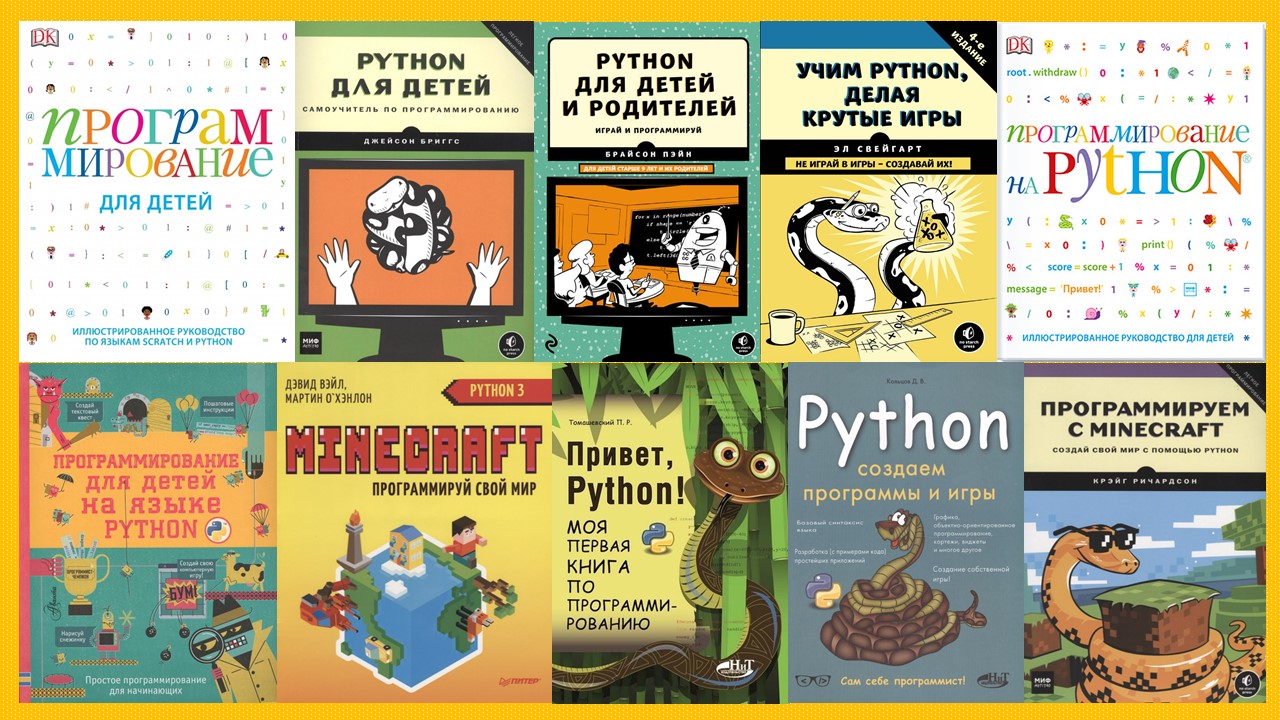
My son became interested in programming in Python, and I had a question - is there an opportunity today to buy a book for a child as a tutorial? Tutorials for adults are not suitable for children - the motivation to wade through the programming textbooks is not always enough for adults, and a child’s boring “academic” presentation can kill all interest in the subject on page five.
Fortunately, at the time of this writing (the end of 2018), the choice was very wide - there are both translated and domestic books aimed at children and teenagers. During the search, dropping out books on Python 2, I was able to find 10 fresh books on Python 3 for children, I studied each of them live in offline stores, and I want to share the results of my research with you in the article under the cut.
For the little ones - fun and with pictures
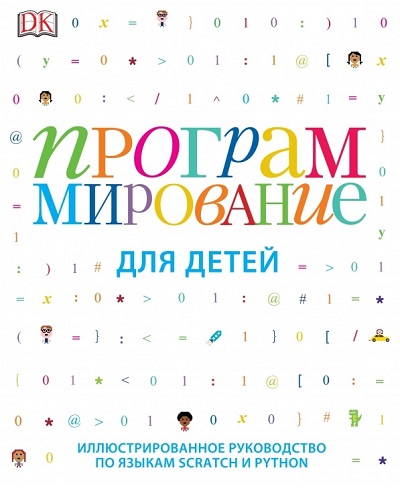
K. Vorderman et al.
Programming for Children: The Illustrated Guide to Scratch and Python , 224 pp.
Publisher: Mann, Ivanov and Ferber, 2017 ISBN: 978-5-00057-472-0, 978-5-00100-073-0, 978-5-00100-557-5, 978-5-00117-348 -9
Carol Vorderman . Computer Guide for Kids: A Unique Step-By-Step Visual Guide, From Binary Code to Buildings Game , 224 pp.
Publisher: DK Children, June 2014
ISBN: 978-1-40934-701-9, 978-0-24118-169-0 (eBook)
Dorling Kindersley is the Ferrari of children's publishing houses. Therefore, on the one hand, buying books with this logo, you can be sure of the quality of both text and printing, but on the other hand, Ferrari is not cheap. All this applies to this particular book to the full - excellent printing quality, thoughtful and aimed at children's perception, but at a cost that is significantly higher than the average for the sample under consideration.
This book is different from all the others in that its target audience is the youngest students, and their familiarity with programming does not begin immediately with Python, but with the visual programming language Scratch, the equivalent of which in our education system is PervoLogo. The information in the book is distributed as follows: 64 pages are devoted to Scratch, 94 pages are Python, and the material is presented in comparison with Scratch, and the last two chapters on 45 pages tell about the organization of computers and the Internet.
The only drawback of this edition from the point of view of the Russian-speaking reader is that the phrases in English used in the example programs are left without translation. A small Russian reader at the target age probably still does not know English so freely as to be able to read them even with a dictionary - and without the help of parents, this is not enough, but reading skills in English can also be improved.
The quality of the printing of the publication is excellent, color printing on good white paper, a semi-solid cover, and a sewn block ensures durability and reliability.
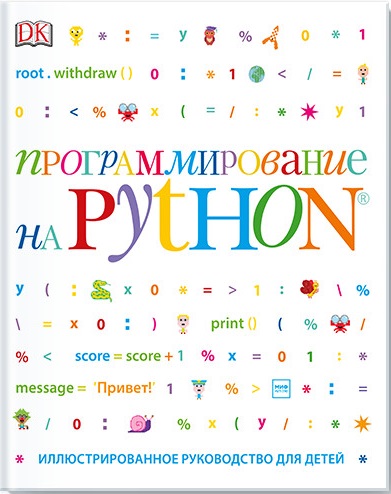
K. Vorderman et al.
Python Programming: An Illustrated Guide for Children , 224 pp.
Publisher: Mann, Ivanov and Ferber, 2018. ISBN: 978-5-00117-399-1
Carol Vorderman . Computer Coding Python Projects for Kids , 224 pp.
Publisher: DK Children, June 2017.
ISBN: 978-0-24128-686-9, 978-0-24131-432-6 (eBook)
The next book in the same series design for more advanced children. All 224 pages entirely devoted only to Python, and this time the publisher including translated all the phrases from the sample programs into Russian. The text of the book and example programs do not duplicate the previous edition - here everything is different, the order of presentation is also slightly different.
And so that you know, Carol Worderman is never a programmer, but a TV star who has led the super-popular puzzle game Countdown for 26 years, under her last name as a well-known brand in Britain published a fair amount of science fiction for children. Her name on the cover helped the book to be sold, and the rest of the team of 5 authors behind the acronym “et al.” Were in charge of the quality substantive part. The same story with the previous book - only a set of 5 real authors is slightly different.
The quality of the printing of the publication is excellent, color printing on good white paper, half-cover, sewn block.

Programming for children in Python , 96 pp.
Publisher: AST, 2017ISBN: 978-5-17982-809-9
Louie Stowell . Coding for Beginners using Python , 96 pp.
Publisher: Usborne Publishing Ltd, March 2017.
ISBN: 978-1-40959-934-0, 978-0-79453-950-4
If the price tags of the first two books in the review you are unpleasantly struck, then, fortunately, we have more affordable option for younger age! Lost authorship in the process of publication in Russian, the book of Louis Sowell is without any discounts a worthy alternative to the previous edition of DK, and is much cheaper. The number of pages is less here - but the book itself is of a larger format, and of a more compact layout, so the volume of the material is almost the same.
In this edition, as well as in the first book of the review, phrases in English from examples of programs into Russian are not translated; the young programmer will need a dictionary or help of parents. But knowledge of the language is not superfluous - so the lack of translation can be considered a plus.
The quality of the printing of the publication is excellent, color printing on good paper, half-hard cover, embroidered block.
For those who are older - more serious and smaller pictures
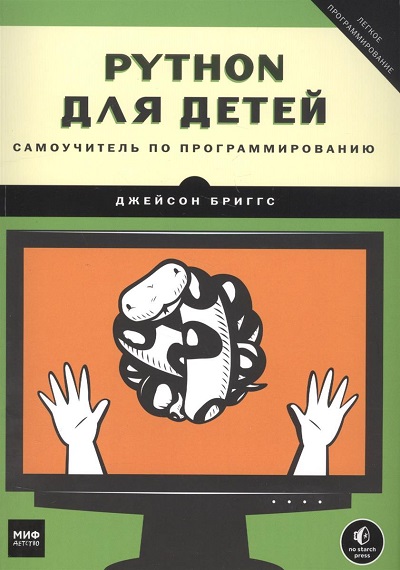
D. Briggs.
Python for Kids: Programming Tutorial , 320 pp.
Publisher: Mann, Ivanov and Ferber, 2018. ISBN: 978-5-00100-616-9, 978-5-00117-231-4
Jason R. Briggs . Python for Kids: A Playful Introduction to Programming , 344 pp.
Publisher: No Starch Press, December 2012.
ISBN: 978-1-59327-407-8
The most venerable book in this review is the 2012 original. The number of positive reviews about it on the Internet is enormous - and the book is really good, but with one important caveat: by structure, this is more of a textbook than a self-help book. With color pictures, but here is a straightforward classic school textbook, with an appropriate approach to the presentation: everything is consistent, with practice, explained in great detail in the calculation for the first time confronted with programming, but, alas, with almost no intermediate results supporting the interest. As a textbook for courses / circles, it is generally ideal, provided that some side interest activity is added. English phrases in the examples are translated.
The quality of the printing of the publication is excellent, color printing on good white paper, thick soft cover, embroidered block.

B. Payne.
Python for Children and Parents , 352 pp.
Publisher: Eksmo, 2017 ISBN: 978-5-69995-169-7
Bryson Payne . Teach Your Kids To Code: A Parent-Friendly Guide To Python Programming , 336 pp.
Publisher: No Starch Press, April 2015.
ISBN: 978-1-59327-614-0
This book is also built as a textbook, but in my opinion more than the previous one is suitable for the title of a self-instruction manual for a child - written in a much more lively language, there are entertaining intermediate results, each chapter summarizes and suggests ideas for self-refinement of the resulting programs (with the ability to download ready-made versions of modifications, if something does not work). English phrases in the examples are translated.
The printing quality of the publication is excellent, color printing on good white paper, hard cover, embroidered block.
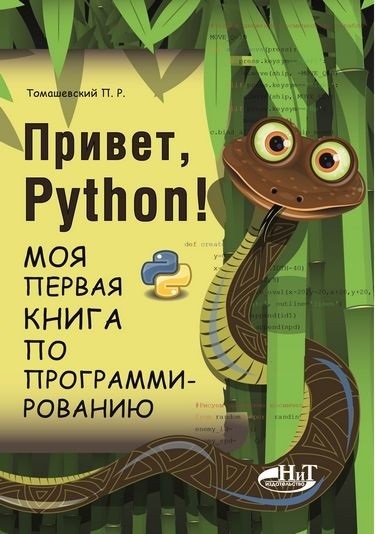
P. Tomashevsky.
Hi, Python! My first book on programming , 256 p.
Publisher: Science and Technology, 2018. ISBN: 978-5-94387-748-3
Another book-textbook, much more "school" than the previous ones - the chapters are called "lessons", each "lesson" is divided into "tasks ", The text is much less animating, intermediate results are never entertaining, but purely functional.
The quality of printing editions - budget, black and white printing on grayish paper, paperback, glued block.
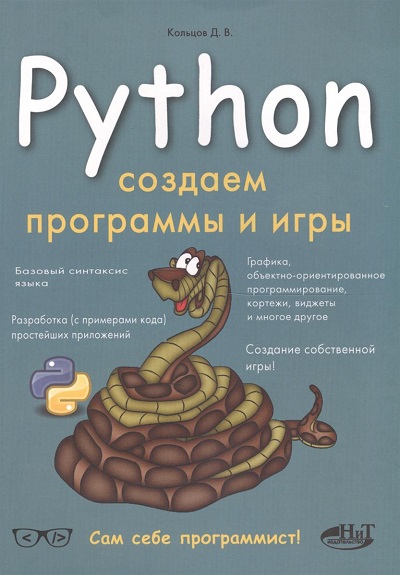
D. Koltsov.
Python: Creating programs and games , 400 pages.
Publisher: Science and Technology, 2017 ISBN: 978-5-94387-746-9
Despite the title, the games in this book take up an insignificant part of the narrative (3 chapters out of 37), this is a classic tutorial for adults that may not intentionally, by virtue of the name and design of the cover, mimics the book for children. Of the advantages - the material on the language in it is set out much more than in the "children's" books, but this edition will not work for a child.
The quality of printing at a minimum: black and white printing on newsprint, very soft cover, glued block.
We learn, playing - it is also possible!
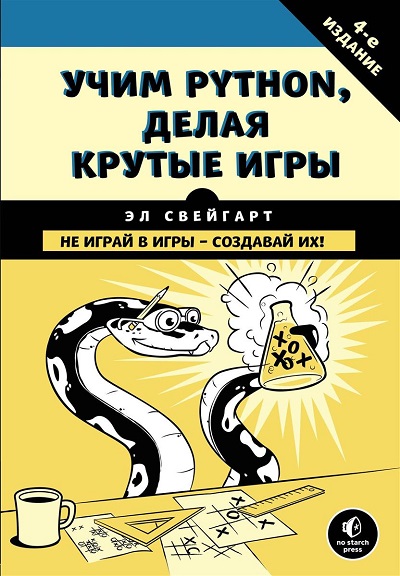
E. Swaygart.
Learning Python by doing cool games , 416 pp.
Publisher: Bombora, 2018. ISBN: 978-5-69999-572-1
Al Sweigart . Invent Your Own Computer Games with Python, 4 edition , 376 pp.
Publisher: No Starch Press, December 2016.
ISBN: 978-1-59327-795-6
The original of this book in English is completely free (in the online version ), so my claims below on the approach to the presentation of the original are not applicable - if you - it does not suit you, then in the world of free cheese you just take another piece, but with a paper book for money you have to choose carefully before starting a banquet.
I didn’t like the approach to the presentation of the material - in each chapter, the reader is first asked to mechanically dial the code of the next game, and then also mechanically read a couple of dozen pages describing what happens in this code. There is no reader involvement in learning - unlike other books in the review. For the “HYIP”, the translation publisher called the games from the book “cool” - however, the author did not promise any particular “coolness” in the original, the games in the book are quite “ordinary”, although quite diverse. From the pros - the presentation goes consistently from simple to complex, and you can really learn how to program from scratch with purely gaming examples from the book. No pictures, English phrases in the examples translated.
Unfortunately, the quality of the printing of this edition is pumped up - black and white printing on white, but translucent paper (shines through the text from the turnover and the next page), plus the texts of the programs are typed in small print (font Condensed). This, alas, does not add convenience to perception — it is actually harder to read than if the paper was originally a newsprint (for example, see the last book in the previous section of the review). Dense soft cover, glued block.
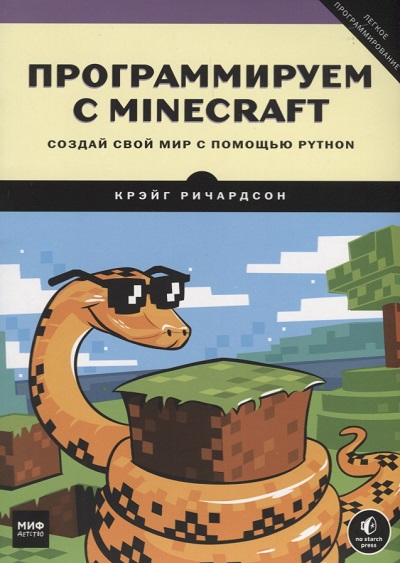
K. Richardson.
We program with Minecraft: Create your own world with Python , 368 pages.
Publisher: Mann, Ivanov and Ferber, 2017 ISBN: 978-5-00100-819-4
Craig Richardson . Learn to Program with Minecraft: Transform Your World with the Power of Python , 336 pp.
Publisher: No Starch Press, December 2015.
ISBN: 978-1-59327-670-6
If your child is a Minecraft fan, then this and the next review book provide a unique opportunity to learn Python without leaving your favorite game. With the help of the proposed examples of programs you can get up in the world of Minecraft such that it is extremely difficult to create manually. Actually, learning goes according to the classical scheme from simple to complex, in each chapter the reader learns new tricks and immediately sees the result. For engaging in the learning process, an unusual technique is used - in terms of examples of programs, small blocks of code are intentionally omitted, which the reader is invited to write independently, guided by a detailed description of the missing functionality and knowledge obtained in previous chapters.
The quality of the printing of the publication is excellent, color printing on good white paper, thick soft cover, embroidered block.

D. Vale, M. O`Hanlon.
Minecraft: Program your world in Python , 224 pages.
Publisher: Peter, 2018. ISBN: 978-5-44610-951-7
David Whale, Martin O'Hanlon. Adventures in Minecraft, 2nd Edition , 320 pp.
Publisher: Wiley, November 2017.
ISBN: 978-1-119-43958-5, 978-1-119-43955-4 (eBook)
Pay attention to the year of publication - in 2016 the first edition of this book was published in Russian (blue cover ) in which Python 2 was used.
According to the authors, even younger schoolchildren can overcome the first half of the book, since besides adapting to Python 3, the second edition was specially reworked by them to simplify the understanding of the meaning and structure of the proposed program examples. A feature of this book is the library of ready-made routines for manipulating objects in Minecraft written specifically for it, due to which impressive visual results can be achieved with less effort on your code.
The quality of the printing of the publication is excellent, color printing on good white paper, thick soft cover, embroidered block.
And if you are already 18+?
Then read this post " Review of literature on the Python language for beginners ", its author hatman is just considering the issue of choosing literature for adults.
But if you still want color pictures and fun examples - then take yourself something from my review!
Note - ISBN Search Features
Книжные магазины и издательства форматируют ISBN-13 дефисами на своих страницах как минимум пятью разными способами. В обзоре я использовал самый популярный формат согласно поисковой выдаче Google – см. ниже количество результатов поиска в зависимости от того, в каком виде забить ISBN в строку поиска. Но имейте в виду – возможны варианты, ищите по-разному и да найдётся вам!
ISBN: 978-5-00057-472-0 – 30 400 страниц
ISBN: 9785000574720 – 5 700 страниц
ISBN: 978-5-000-57472-0 – 5 результатов (все мимо)
ISBN: 978-5-0005-7472-0 – 5 результатов (все мимо)
ISBN: 978-5000574720 – ровно 1 результат, но это Amazon!
ISBN: 978-5-00057-472-0 – 30 400 страниц
ISBN: 9785000574720 – 5 700 страниц
ISBN: 978-5-000-57472-0 – 5 результатов (все мимо)
ISBN: 978-5-0005-7472-0 – 5 результатов (все мимо)
ISBN: 978-5000574720 – ровно 1 результат, но это Amazon!
